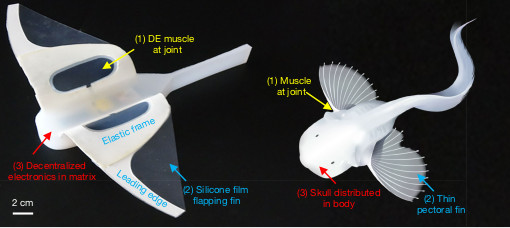This article is more than 1 year old
Soft-shell robot uses snailfish features to sail though Mariana Trench stress test
Deep sea submersible may help humans explore deepest oceans
Researchers in China have developed flexible submersible robots that experts say might one day help humans reveal the secrets to unexplored depths of the Earth's vast oceans.
Using flexible materials such as silicone, embedded and distributed electronic controls, and a bio-mimicking propulsions system, Zhejiang University professor Tiefeng Li and his colleagues have shown how engineers might overcome the limitations of rigid robots in deep sea research.
Published in Nature this week, the study shows soft machines were able to operate in the famous Mariana Trench at a depth of 10,900m, further under the ocean's surface than the peak of Mount Everest is above it.
Under pressure
Rigid robots in underwater environments struggle to withstand ever-increasing stress the further down they go. Their conventional control systems need to be encased and protected from pressures of more than a thousand times standard atmospheric pressure at sea level. They require watertight enclosures made of metallic materials the thickness and dimensions of which need to increase to cope with greater depths.
“To explore depths ranging between 3,000m and 11,000m, rigid robots and machines require pressure vessels or pressure-compensated systems. However, deep-sea exploration remains challenging, given the risk of structural failure under extreme conditions,” the researchers said.
Instead of engaging in this war of attrition against the elements, the research team took inspiration from nature.
“Soft-bodied organisms living at medium ocean depths [of more than 1,000m] such as octopuses and jellyfish, have been widely studied; their adaptability has inspired the design of underwater soft robots. Elegant soft robot designs present promising approaches to deep-sea exploration,” the paper – "Self-powered soft robot in the Mariana Trench" – said.
In particular, the researchers looked at how evolution had solved the thorny control system problem in the hadal snailfish, which has recently been discovered at ocean depths around 8,000m. Its body features a distributed, partly open skull and flapping pectoral fins, both of which guided the mechanical design of the researchers’ deep-sea soft robot with onboard power, control and dielectric elastomer actuators.
Hence, in the deep sea floppy bot, the electronics, including a battery, a micro-control unit and a voltage amplifier, are encapsulated in a matrix within a polymer. “If the electronic components are densely packed together on a single printed circuit board, pressure tests indicate that failures occur at their interfaces,” the research paper said.
To enhance the pressure resilience, the boffins mitigated the shear stress by using a decentralised design in which the components were wire-connected with or separated onto several smaller printed circuits. They also detached the transformer from the circuit board, and increased the distance between microchips by removing of direct rigid contacts among electronic components.
Meanwhile, for propulsion, the fins are attached to artificial muscles which are made of a soft material that converts electrical energy into mechanical work. Tiny solid structures mechanically connect the contracting muscles to the fins, making them flap.
Results from lab tests showed the stresses, under the same pressure on the components was much less than in the centralised, rigid robot design.
The robot was successfully tested in the South China Sea, where it free-swam by flapping locomotion. It also came through tests in the Mariana Trench where it was tethered to a conventional underwater robot, which also took images of the mission.
It's not exactly fast though, swimming at roughly 5cm per second.
Still, the remarkable progress in robot design for extreme underwater environments could help reveal more of this largely unexplored expanse of Earth. The number of people that have descended to the Mariana Trench can be counted on one hand, fewer than have stepped on the Moon.
In an accompanying article, professor Cecilia Laschi of the Department of Mechanical Engineering at the National University of Singapore, and Marcello Calisti, senior lecturer at the University of Lincoln in the UK, said: “Li and co-workers’ research now pushes the boundaries of what can be achieved: the replacement of rigid protective enclosures for electronic components by distributed electronics embedded in a soft material paves the way to a new generation of deep-sea explorers.”
Such robots could “help researchers to explore the vast uncharted depths of the oceans,” the commentators said.
But clearly work needs to be done on the robot’s speed. It could not withstand sizeable disturbances and could easily be swept away by underwater currents. ®

